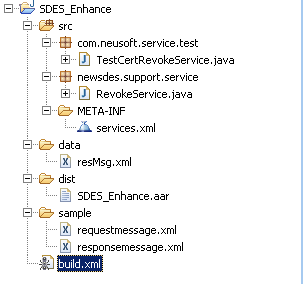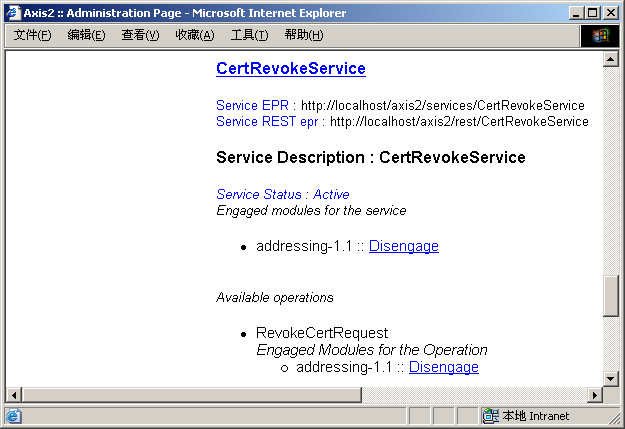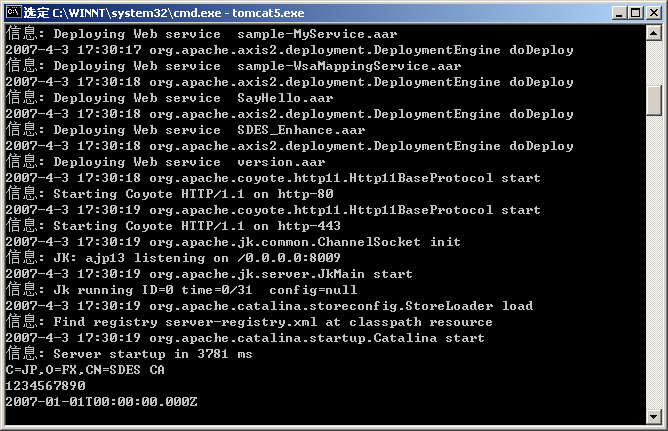SOAP与AXIS2入门教程(附带实例)
最近项目需要用到SOAP以及AXIS2的知识,在学习之余,将第一天学到的内容整理了一下,一来做为笔记做个记录,二来如果有需要的,可以做为参考,今天主要是完成了一下功能,通过一个SOAP请求消息(可以自己构造也可以通过指定一个xml文件),然后在Web Service中获取这个SOAP请求消息(一个OMElement对象),通过解析这个对象,获取需要的信息,然后对这些信息进行业务处理,最后返回一个SOAP响应消息。
获取AXIS2 1.1,由于做项目一般使用稳定的发布版本,所以本文没有使用最新的AXIS2 1.1.1版本,该版本可以从Apache官方网站下载。下载地址如下:
http://ws.apache.org/axis2/download/1_1/download.cgi
在上面连接中,有三个版本的axis2可以供下载,分别是:
Standard Binary Distribution,Source Distribution,WAR (Web Archive) Distribution,其中标准版可以直接独立使用(Stand-alone),源代码版本需要使用maven进行构建,同时允许开发人员自己修改源代码,本文使用的是WAR版本,可以直接发布在WEB容器中(本文使用的是Tomcat5.5.17)。在上面的链接中还有一个是DOCS的下载,最好一并下载,docs中包含用户手册,快速上手指南,以及其他相关文档,对了解并熟悉AXIS2很有帮助。
闲话少说,将已经下载的WAR包发布(拷贝+粘贴)到%TOMCAT_HOME%/webapps/目录下,其中%TOMCAT_HOME%以Tomcat安装目录进行替换。启动Tomcat,在IE地址栏中键入:
http://localhost:8080/axis2,如果部署成功,即可看到欢迎页面,一般情况下不会出现什么错误。
进入主页之后,可以通过进入Administration链接来管理WEB服务,其中初始化用户名和密码分别为admin/axis2。一般情况下,在管理控制台下进行操作比较方便,但是本文将直接进行操作系统目录级的操作(不会使用UploadServices进行发布服务,而是直接将*.aar拷贝到%TOMCAT_HOME%/webapps/axis2/WEB-INF/services目录下)。
下面我们建立自定义的WEB服务:
我们要将类似以下XML格式的SOAP请求转换为SOAP响应,并获取SOAP请求中的关键元素,进行业务操作,本例子中只是简单的将数值拷贝,没有进行实际的业务操作,但是在代码中进行了指示:
SOAP请求:
SOAP响应:
在实际应用中,我们可能要获取ABC,DEF,GHI来进行业务处理,最后返回一个其他的消息,但是在示例中,我们仅仅获取ABC,DEF,GHI,然后打印出来,并返回GHI。
Step1.建立工程并创建文件
建立如下图所示的JAVA工程(工程的源代码路径与编译后路径不同,源代码为project/src,编译后为project/bin):首先建立一些类,然后创建serives.xml,最后建立build.xml文件(ANT的构建文件,为了方便测试与构建,所以使用了ANT)
下面是这些文件的内容:
RevokeService.java(这个是进行WEB服务的类):
package newsdes.support.service;
import java.io.FileNotFoundException;
import java.io.FileOutputStream;
import java.io.IOException;
import javax.xml.namespace.QName;
import org.apache.axiom.om.OMAbstractFactory;
import org.apache.axiom.om.OMElement;
import org.apache.axiom.om.OMFactory;
import org.apache.axiom.om.OMNamespace;
public class RevokeService {
/**
* The request soap message object.
*/
public static OMElement requestSoap = null;
/**
* Write the soap response message to xml file.
*
* @param res
* The resource of that forms the xml file.
* @param filePath
* The path where the xml file be stored.
*/
private static void writeResponse(String res, String filePath) {
try {
FileOutputStream fos = new FileOutputStream(filePath);
byte[] bytes = res.getBytes();
fos.write(bytes);
fos.close();
} catch (FileNotFoundException e) {
e.printStackTrace();
} catch (IOException e) {
e.printStackTrace();
}
}
/**
* Generate the path where the xml file is stored.
*
* @param fileName
* @return
*/
private static String makePath(String fileName) {
String path =
"C:/eclipse/workspace/SDES_Enhance/data/" + fileName;
return path;
}
//主要的WEB服务方法
public OMElement RevokeCertRequest(OMElement soapBody) {
requestSoap = soapBody;
QName issuerName = new QName("Issuer");
QName serialName = new QName("Serial");
QName revocationDateName = new QName("RevocationDate");
OMElement issuerElement =
requestSoap.getFirstChildWithName(issuerName);
OMElement serialElement =
requestSoap.getFirstChildWithName(serialName);
OMElement revocationDateElement = requestSoap
.getFirstChildWithName(revocationDateName);
String issuer = issuerElement.getText();
String serial = serialElement.getText();
String revocationDate = revocationDateElement.getText();
// print out the value
System.out.println(issuer);
System.out.println(serial);
System.out.println(revocationDate);
// TODO use "issuer,serial,revocationDate" to do business
// Generate the soap response message
OMFactory soapFactory = OMAbstractFactory.getOMFactory();
OMNamespace omNs = soapFactory.createOMNamespace(
"http://www.sdes.net/", "");
OMElement soapResponse = soapFactory.createOMElement(
"RevokeCertResponse", omNs);
OMElement soapMain = soapFactory.createOMElement("RevokeDate", omNs);
soapMain.setText(revocationDate);
soapResponse.addChild(soapMain);
soapResponse.build();
String path = makePath("resMsg.xml");
writeResponse(soapResponse.toString(), path);
return soapResponse;
}
}
该Service类主要实现了将传入的参数OMElement进行解析,获取其中的Issuer,Serial以及RevocationDate元素的值,然后进行业务处理(蓝色部分,省略)。然后根据业务操作结果,将响应返回。(这里仅仅是将内容写入到一个XML文件中)。
services.xml(WEB服务的配置文件,放置在META-INF目录下):
<
serviceGroup
>
<
service
name
=
"CertRevokeService"
>
<
description
>
This is the service for revoking certificate.
description
>
<
parameter
name
=
"ServiceClass"
locked
=
"false"
>
newsdes.support.service.RevokeService
parameter
>
<
operation
name
=
"RevokeCertRequest"
>
<
messageReceiver
class
=
"org.apache.axis2.receivers.RawXMLINOutMessageReceiver"
/>
<
actionMapping
>
urn:RevokeCertRequest
actionMapping
>
operation
>
service
>
serviceGroup
>
其中
serviceGroup
中可以包含多个
service,
如果只有一个的时候,可以省略外层的
serviceGroup
元素。服务名为
CertRevokeService
。主要业务操作为
RevokeCertRequest
。
红色部分标志了进行
WEB
服务的主要类。
Step2:进行打包
首先编写build.xml文件,为了简便(只是个例子,所以任务也比较简单,只是将project/bin目录下的内容进行JAR打包,文件名为SDES_Enhance.aar,其中.aar为AXIS2的应用的后缀名。)
Deploy SDES_Enhance Services
打包完成后,直接将SDES_Enhance.aar部署到
%TOMCAT_HOME%/webapps/axis2/WEB-INF/services目录下,在TOMCAT启动情况下,会进行HOT-DEPLOY,直接部署完成,在
http://localhost:8080/axis2/axis2-admin/listService
下刷新,可以看到部署的服务:
CertRevokeService
。如下图所示:
Step3:编写客户端测试代码:
建立测试类:TestCertRevokeService(通过构造一个SOAP请求对象,传入给服务,来实现返回一个SOAP响应的XML文件):
TestCertRevokeService.java
package com.neusoft.service.test;
import org.apache.axiom.om.OMAbstractFactory;
import org.apache.axiom.om.OMElement;
import org.apache.axiom.om.OMFactory;
import org.apache.axiom.om.OMNamespace;
import org.apache.axis2.AxisFault;
import org.apache.axis2.addressing.EndpointReference;
import org.apache.axis2.client.Options;
import org.apache.axis2.client.ServiceClient;
public class TestCertRevokeService {
private static EndpointReference targetEPR = new EndpointReference(
"http://localhost/axis2/services/CertRevokeService");
public static OMElement getSoapRequestMessage() {
OMFactory factory = OMAbstractFactory.getOMFactory();
OMNamespace omNs =
factory.createOMNamespace("http://www.sdes.net", "");
OMElement issuer = factory.createOMElement("Issuer", omNs);
OMElement serial = factory.createOMElement("Serial", omNs);
OMElement revocationDate =
factory.createOMElement("RevocationDate",
omNs);
issuer.setText("C=JP,O=FX,CN=SDES CA");
serial.setText("1234567890");
revocationDate.setText("2007-01-01T00:00:00.000Z");
OMElement requestSoapMessage = factory.createOMElement(
"RevokeCertRequest", omNs);
requestSoapMessage.addChild(issuer);
requestSoapMessage.addChild(serial);
requestSoapMessage.addChild(revocationDate);
requestSoapMessage.build();
return requestSoapMessage;
}
/**
* @param args
*/
public static void main(String[] args) {
OMElement requestSoapMessage = getSoapRequestMessage();
Options options = new Options();
options.setTo(targetEPR);
ServiceClient sender = null;
try {
sender = new ServiceClient();
sender.setOptions(options);
sender.sendReceive(requestSoapMessage);
} catch (AxisFault e) {
System.out.println(e.getFaultElements().toString());
}
}
}
其中,Options对象的setTo方法一定要写正确,这是将SOAP请求发送的终点,如果书写不对,将不能通过WEB服务来处理请求。
执行TestCertRevokeService类,可以看到在控制台(Tomcat)的控制台打印出了在CertRevokeService中要打印的消息。


